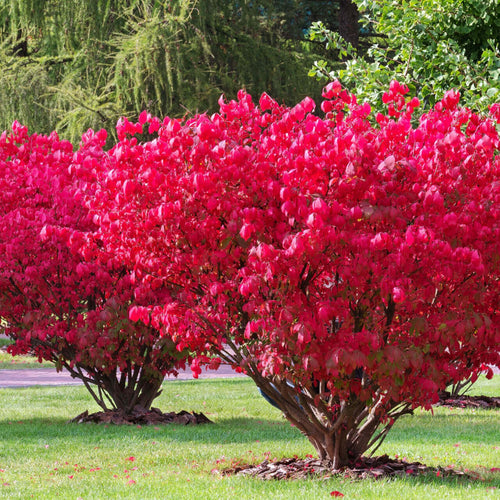Burning Bush
Burning bush leaves turn a brilliant shade of fiery red in autumn, adding a splash of color and drama to the landscape. This seasonal transformation makes it an excellent focal point or accent plant in any garden or backyard, providing a captivating view as the weather turns cooler. It is a versatile and visually striking shrub with numerous landscaping benefits. Its unique characteristics and adaptability make it popular among gardeners and landscape designers.
Burning Bush is named after its bright red fall colors, which make for an incredible display. This large, rounded shrub has become a very common sight in American gardens, forests, and landscaping alike. Normally planted in spring, they grow somewhat slowly, but if it is taken care of properly, it can last for many decades.
Where Do Burning Bushes Grow
Officially designated as Euonymus alatus, they are native to northeastern Asia and specifically to Russia, China, Japan, and Korea. It was originally introduced in the United States and Canada for display, and it has remained popular ever since. They thrive best in forests or thickets, where they can receive a good balance between sunlight, shade, and somewhat moist conditions. It can grow well in many soil types and, therefore, can adapt well to different kinds of woodlands. Today, people commonly plant them alongside fences, roadsides, commercial plazas, and the borders of forests.
Description of the Burning Bush
They can grow to be anywhere from ten to twenty feet tall and be equally as wide. The stems of this shrub have four ‘wings,’ from which the distinctive deep red leaves grow. Each of the leaves can grow to be up to three inches long and one inch wide. When the blooms in the late spring to early summer, you’ll notice the green-looking flower. By late summer to early fall, the fruits manifest in the form of red, round berries enclosed in an orange or yellow capsule.
Why Do Gardeners Like the Burning Bush
Gardeners mainly like the Burning Bush for its bold and sprightly bright red appearance. Beyond that, it’s a very adaptable shrub that does well in only moderately moist soil and with partial shade from the sun. It will need weekly pruning to help ensure it remains a manageable size. It’s by the fall that the brilliant red display of the shrub will be at its brightest and most alluring, which is precisely what people who plant this shrub look forward to the most.
Create a Beautiful Setting With Burning Bush
Burning bushes bloom each year from late May through June. The blooms feature small flowers that are usually a yellow-green color. The dense, green foliage of the bushes often obscures the appearance of these flowers. During spring, the leaves develop a blue color and then turn bright red in the fall. From July through October, the flowers mature, turning into small red fruits. The leaves develop a green-brown hue during the winter. The bushes can reach heights of up to 20 feet and be just as wide. Most of them have multiple corky-textured stems and branches, as well as four ridges that resemble square corners.
They make great focal points in yards and gardens because of their attractive foliage and spherical shape. In spring and summer, their bright crimson leaves, along with their berries, add lots of vibrancy to outdoor areas. You can plant a single bush to stand alone by itself or plant several together to create larger decorative accents.
They feature a dense, bushy growth habit, which makes them ideal for creating neat and defined borders and edges. Because of their broad shape, the bushes are ideal for planting in containers around flowerbeds. You can easily prune them to keep the desired border size and shape. Because they are drought-tolerant, you can even use them in areas with limited soil moisture.
Add Natural Privacy With Burning Bush
They have thick foliage that creates natural privacy. They can creates a tall barrier to block views from nearby houses. Their dense foliage remains all year, giving you year-round privacy. These bushes usually grow about a foot each year. Because of how quickly they grow, they are particularly useful for bridging spaces between flower beds, increasing the seclusion they provide. They are easy to shape to the height and density you wish to attain the privacy you desire.




















































